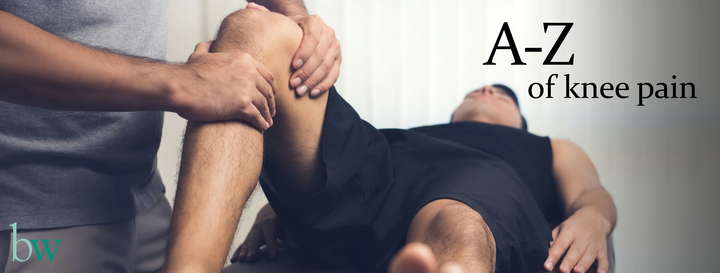Knee Pain – it seems so simple but it can quickly become so confusing! Getting good advice based on the latest research can be tricky!
Still got questions – attend our FREE seminar on Knee Pain – Wednesday 19 June 11.30
The knee is the largest joint in the body.
- 4 bones
- more than 20 muscles each with a tendon
- 4 major ligaments as well as many little ones
- and at least 3 layers of cartilage.
Here’s my A to Z of knee pain
Arthroscopy
An operation to “clean” inside the knee joint. Results of a 10 year study reports that arthroscopic surgery results are NO better than placebo surgery!! Sadly, despite this monumental finding, thousands have this operation every year.
Bakers Cyst
Swelling at the back of the knee which can make walking uncomfortable and compromises movement.
Cortico-steroids
Usually given via injection these are to temporarily reduce inflammation (and therefore pain). They are NOT a long term solution, just a short term emergency pain relief. There is increasing research suggesting they can damage joints if used long term.
Diet
Visceral fat (the fat around the tummy) increases joint inflammation. More weight also puts more load on joints like the knee.
Extension
Getting the knee straight is of critical importance and is often the first movement to go. This is what causes the limp.
A bent knee can then cause hip and back problems as the whole lower body is out of alignment.
Feet
Your knee is the biggest shock absorber for every step you take, so if there is shock or twist from the feet, the knee is going to take the strain. Correcting the feet can relieve the strain on the knee, reduce pain and prevent the situation getting worse.
Glucosamine
With chondroitin was recommended to help “lubricate” joints. Recent research suggests it may not be that effective and movement is more effective (and often free!)
Hips
Pain from the hips is often referred to the knee and vice versa. Make sure both are checked before starting treatment!
Ice
Numbs the pain and reduces swelling. Wrap an ice pack or frozen peas in a damp cloth, to prevent ice burns, and apply for 10 minutes every half hour.
Joint Replacement
When the knee is replaced with a titanium joint. People are often refused if they are “too young” as the replacements often only have a lifespan of 5 – 10 years. Consider this as a last resort!
Knee Movement
Full range of movement matters. Matters to how you walk and therefore the effect on all the other muscles and movements in your body. Get strong and straight and pain reduces
Limping
If not corrected, limping can cause problems in the back and hips. These problems can’t be resolved until the knee problem is fixed.
A German technology for the treatment of osteoarthritis and degenerative joint disease. This treatment strengthens and reinforces the cartilage, ligaments and tendons in the joint. It reduces inflammation and pain, allowing you to get your exercise regime going. We have over a 90% success rate for knees!
Nothing
Unfortunately waiting for it to “go away on its own” doesn’t always work, especially as you get older. It is always best to be proactive, the sooner you act the easier, quicker and more effective treatment is.
The dreaded “things in your shoe”. Fortunately technology has moved on and they are now slim and discreet enough to fit in the shoes you already own.
Physical Therapy
American research shows that exercise significantly improves movement and reduces pain in the knee. The 1st muscle to lose strength in any knee problem is the quadriceps so focus these. Exercise is not easy at first but get advice and persevere! Stretch and strengthen!
Q Angle Correction:
The angle formed by your thighbone and shinbone through the knee cap when viewed from the front. If you are knock-kneed or bandy-legged this angle is wrong, putting extra pressure on the knee and increasing wear and tear
Referred Pain
Getting an accurate diagnosis is critically important! Pain in the knee can be referred from the hip or the feet and without an accurate assessment, treatment is a waste of time as you are not treating the true cause of the problem.
Supports
Are not all created equal! It is important to get the right one for your knee problem and the activity you want to do. New specialized techniques using tape are also effective. Elastic supports stifle the circulation and restrict movement.
Tissue Engineering
Or stem cell regeneration. This is a new surgery technique which implants cartilage from elsewhere aiming to stimulate cartilage re-growth but has mixed results to date.
Ultrasound
Used by physiotherapists, this therapy uses sound waves to reach deep tissues and increase blood flow, relax muscles and aid healing.
Viscosupplementation
Injections of hyaluronate into the joint to lubricate it but not cure it. The injection can be painful and only offers short term pain relief.
Water
Exercising in your swimming pool takes the weight off your knees. Over and over again research shows that exercise can reduce knee pain, and is a MUST!
X-rays
And other investigations can give you a clearer idea of how advanced the problem is. Always make sure you get the right investigation for your problem, this should follow a detailed clinical assessment.
Youth
Osgood-Schlatter Syndrome can affect teenagers and youngsters as they grow. Often misnamed “Growing Pains” it’s simple to reduce the pain and onward symptoms.
Zig Zag
Left knee and right hip? Left ankle and right knee? Pain that started in the left knee and moved to the right? Shooting or stabbing pains? All signs that a more thorough assessment is needed as the root cause might not be where you’re feeling your pain today.
For more information on knee pain check out our website www.TheBodyworksClinic.com, our Facebook page “Bodyworks Health Clinic” or attend our FREE seminar on Wed 19 June at 11.30 – places are limited so please book to get a spot!


